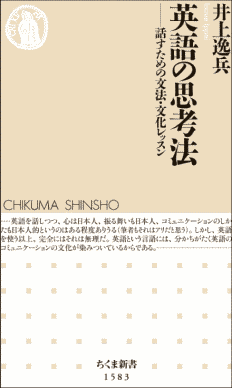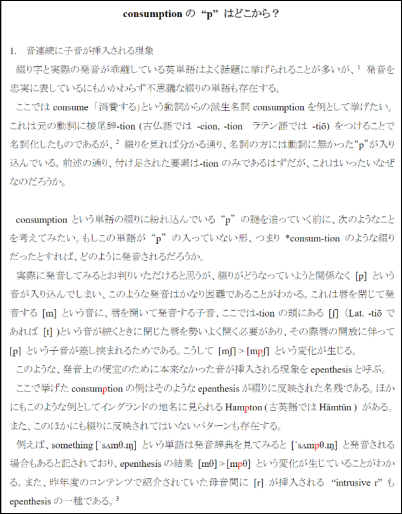2023-05-27 Sat
■ #5143. Voicy heldio で「#726. 井上逸兵さんとの雑談生放送」をアーカイヴとして公開 [notice][voicy][heldio][youtube][link][inoueippei]
一昨日5月25日(木)の午後1時より,同僚の井上逸兵さんと,Voicy 「英語の語源が身につくラジオ (heldio)」にて久しぶりの雑談生放送をお届けしました.30分強のカジュアルトークでしたが,YouTube の裏話,話し方のコツ,会話の「間」の問題,ポスト自動翻訳時代についてなど,楽しい話題が次々に展開しました.生放送でお聴きくださったリスナーの皆さん,事前に質問を寄せてくださった方々には感謝申し上げます.
今朝の Voicy heldio で,生放送を収録しておいたものをアーカイヴとして公開しました.「#726. 井上逸兵さんとの雑談生放送」をお聴きください.井上さんに再び出演・対談していただけるよう,皆様からのその趣旨のコメントもお待ちしています(Voicy のコメント欄よりどうぞ).
井上さんとは過去にも3回ほど Voicy heldio で対談し,配信しています.
・ 「#108. 『英語の思考法』(ちくま新書)の著者,井上逸兵先生との対談」 (2021/09/17)
・ 「#144. 対談 井上逸兵先生と「英語新書ブーム」を語る」 (2021/10/22)
・ 「#316. 井上逸兵先生との対談 YouTube を始めて1月半になりますが」 (2022/04/12)
今回の配信中でも触れていますが,井上さんとは昨年2月26日に「井上逸兵・堀田隆一英語学言語学チャンネル」を開設し,毎週水・日の午後6時に新作動画を公開してきました.順調に回を重ね,最新作は第130回となっています.こちらもチャンネル登録していただければ幸いです.Voicy heldio では,この YouTube チャンネル関連でも何度かお話ししています.
・ 「#272. 井上逸兵先生と YouTube を開始,そして二重否定の話し」 (2022/02/27)
・ 「#663. 私の幸せは井上逸兵先生との YouTube 収録です」 (2023/03/25)
本ブログの井上さん関連記事としては inoueippei をご覧ください.とりわけ「#4526. 井上逸兵(著)『英語の思考法 ー 話すための文法・文化レッスン』」 ([2021-09-17-1]) では,最新のご著書を紹介しています.

今回の配信の最後のほうで触れているように,井上さんは「NPO 法人地球ことば村」の理事長でもあります.また,井上さんのツイッター @ippeiinoue もおもしろいので,ぜひフォローを!
・ 井上 逸兵 『英語の思考法 ー 話すための文法・文化レッスン』 筑摩書房〈ちくま新書〉,2021年.
2023-05-25 Thu
■ #5141. shibboleth 「試し言葉」 [cryptology][sociolinguistics][bible][hebrew][wycliffe][voicy][heldio][youtube]
5月21日(日)に公開された「井上逸兵・堀田隆一英語学言語学チャンネル」の最新回は「#129. 言語を暗号として見るとこんなにおもしろいことが!」です.
動画の10:24辺りで,井上さんが旧約聖書の「士師記」 (Judges 12:4--6) に出典を求められる shibboleth 「シボレテ」の話題に言及しています.この語は,語源的にはヘブライ語で「洪水」(あるいは「穀物の穂」)を意味する šibbolet に遡ります.敵対するエフライム人 (Ephraimites) が [ʃ] 音を発音できないことから,ギレアデ人 (Geleadites) が敵を見分けるためにこの語を用いたというエピソードです.これにより,ギレアデ人は4万2千人のエフライム人を処分したといいます(cf. 「#3623. ヘブライ語からの借用語」 ([2019-03-29-1])).民族を選別するための「試し言葉,合い言葉」です.
OED によると,この語の英語での初出は1382年の Wycliffe の聖書においてです.
1. The Hebrew word used by Jephthah as a test-word by which to distinguish the fleeing Ephraimites (who could not pronounce the sh) from his own men the Gileadites (Judges xii. 4--6).
1382 Bible (Wycliffite, E.V.) Judges xii. 6 Thei askiden hym, Seye thanne Sebolech [1535 Coverdale Schiboleth, 1611 Shibboleth],..the which answerde, Shebolech [a1425 L.V. Thebolech, 1535 Siboleth, 1611 Sibboleth].
1611年の The Authorised Version (The King James Version [KJV]) と日本語口語訳より,問題の「士師記」 (Judges 12:4--6) を引用しておきましょう.
4 Then Jephthah gathered together all the men of Gilead, and fought with Ephraim: and the men of Gilead smote Ephraim, because they said, Ye Gileadites are fugitives of Ephraim among the Ephraimites, and among the Manassites. 5 And the Gileadites took the passages of Jordan before the Ephraimites: and it was so that when those Ephraimites which were escaped said, Let me go over; that the men of Gilead said unto him, Art thou an Ephraimite? If he said, Nay; 6 Then said they unto him, Say now Shibboleth: and he said Sibboleth: for he could not frame to pronounce it right. Then they took him, and slew him at the passages of Jordan: and there fell at that time of the Ephraimites forty and two thousand.
4 そこでエフタはギレアデの人々をことごとく集めてエフライムと戦い,ギレアデの人々はエフライムを撃ち破った.これはエフライムが「ギレアデびとよ,あなたがたはエフライムとマナセのうちにいるエフライムの落人だ」と言ったからである.5 そしてギレアデびとはエフライムに渡るヨルダンの渡し場を押えたので,エフライムの落人が「渡らせてください」と言うとき,ギレアデの人々は「あなたはエフライムびとですか」と問い,その人がもし「そうではありません」と言うならば,6 またその人に「では『シボレテ』と言ってごらんなさい」と言い,その人がそれを正しく発音することができないで「セボレテ」と言うときは,その人を捕えて,ヨルダンの渡し場で殺した.その時エフライムびとの倒れたものは四万二千人であった.
YouTube 動画の11:03以降で,井上さんが,ウクライナ語で「パン」を意味する「パリャヌィツャ」の発音が,ロシア語話者(のスパイ)を排除するために用いられているという話をしています.言語の恐るべき排除機能に,目を向けてみてはいかがでしょうか.
この話題については,昨日の Voicy 「英語の語源が身につくラジオ (heldio)」でもお話ししました.「#723. shibboleth 「試し言葉」 --- 言語の恐るべき排除機能」です.
2023-05-21 Sun
■ #5137. heldio 「#716. 英語史を学ぶなら音声学もしっかり学ぼう」の収録の様子を動画撮影しました --- 英語史情報発信の活性化のために [voicy][heldio][heltube][phonetics][phonology][hel_education][youtube]
毎朝6時に配信している Voicy 「英語の語源が身につくラジオ (heldio)」の5月17日分の放送回として「#716. 英語史を学ぶなら音声学もしっかり学ぼう」をお届けしました.このブログや heldio などを通して英語史に関心を抱き,もう一歩深く入り込んでみたいという方は,ぜひ音声学 (phonetics) と音韻論 (phonology) を学んでいただければと思います.
上記放送回で,英語史を学ぶに当たって音声学も一緒に学びたい理由として4点を挙げました.以下,箇条書きしておきますので復習してください.
(1) 話し言葉こそが universal だから
(2) 現在と過去を行き来するために
(3) 音の変化が文法の変化をもたらしたから
(4) 話し言葉と書き言葉との関係を押さえるために
hellog と heldio の関連記事・放送回を3点ほど掲げておきます.
・ hellog 「#4231. 英語史のための音声学・音韻論の入門書」 ([2020-11-26-1])
・ heldio 「#712. ハヒフヘホ --- khelf メンバーと学ぶコトバの「音」入門」
・ heldio 「#703. 母音「あいうえお」入門 --- ゆる言語学ラジオ(著)『言語沼』にインスピレーションを受けて」
さて,今日のこの記事の主眼は「英語史を学ぶなら音声学も一緒に」を改めて叫ぶことではありません.上記 heldio 放送回 #716 の収録の様子を動画として撮影したので,それをご覧くださいという宣伝です.これは Voicy 収録の様子をただお見せしたいというわけではなく,学術・教育の情報発信の手段として Voicy のような音声メディアが優れていることを,潜在的発信者の方々に伝えたかったからです.YouTube などの動画メディアは制作に相当な手間暇がかかりますが,音声メディアであれば,ずっと優れたタイパやコスパで情報を発信できます.
上記 heldio 放送回 #716 は,3チャプター合計で14分51秒ほど私が実際に話して収録しています.この収録の様子の一部始終を動画撮影してみたのですが,heldio 収録には含まれない前口上,チャプター間の一服,締めの言葉をすべて含め,動画撮影の総時間は21分20秒でした.この後,放送回やチャプターのタイトル付け,ハッシュタグ付け,リンク貼り,配信予約などの作業が続きますが,それでもプラス5分程度です.つまり,15分弱の1回の放送回の制作にかかる実質的な時間は,20分ほどだということです.もし YouTube で同じコンテンツを制作しようとすると,かりに最小限の編集で済ませるにせよ,20分という時間では無理でしょう.少なくとも2,3倍の時間はかかります.
以下がその動画「heldio 2023年5月17日放送回の収録の様子」です(YouTube 版はこちらからどうぞ).
音声メディアなどを通じて英語史の情報を発信する方が増えてくれるとよいなと思っています.ぜひ参考になれば.(なお,以前にも一度「#4815. Voicy 「英語の語源が身につくラジオ (heldio)」の収録の様子です」 ([2022-07-03-1]) として heldio 収録の様子をお届けしています.)
2023-05-14 Sun
■ #5130. 「ゆる言語学ラジオ」周りの話題とリンク集 [youtube][yurugengogakuradio][notice][heldio][voicy][note][link]
5月6日,9日の2回にわたり YouTube チャンネル「ゆる言語学ラジオ」 (yurugengogakuradio) にお邪魔してきました.英単語の語源や綴字について,ゆるい「喜怒哀楽」の観点から,雑談しました.パーソナリティのお二人,堀元さんと水野さんには,たいへんお世話になりました.
・ 第1弾 「#227. 歴史言語学者が語源について語ったら,喜怒哀楽が爆発した【喜怒哀楽単語1】」(5月6日)
・ 第2弾 「#228. 「英語史の専門家が through の綴りを数えたら515通りあった話【喜怒哀楽単語2】」(5月9日)
これまで「ゆる言語学ラジオ」の監修,出演,関連するコンテンツの公表を重ねてきました.「hellog~英語史ブログ」,「英語の語源が身につくラジオ (heldio)」,note,「井上逸兵・堀田隆一英語学言語学チャンネル」などで雑多に取り上げてきましたが,この辺りで時系列にリンクをまとめておきたいと思います.
・ 2023年1月10日,「ゆる言語学ラジオ」監修回 (1) 「#193. ghoti と書いてフィッシュと読む?英語学ジョークを徹底解剖【発音1】」
・ 2023年1月13日,hellog 記事 「#5009. なぜバーナード・ショーの綴字ネタ「ghoti = fish」は強引に感じられるのか?」 ([2023-01-13-1])
・ 2023年1月14日,「ゆる言語学ラジオ」監修回 (2) 「#194. フランスかぶれ・悪筆・懐古厨.綴りの変遷理由が意外すぎる.【発音2】」
・ 2023年1月15日,hellog 記事 「#5011. 英語綴字史は「フランスかぶれ・悪筆・懐古厨」!? by ゆる言語学ラジオ」 ([2023-01-15-1])
・ 2023年1月15日,note 記事 「「ゆる言語学ラジオ」の ghoti 回にまつわる堀田リンク集」
・ 2023年1月16日,heldio 放送回 「#595. heah/hih/high --- 「ゆる言語学ラジオ」から飛び出した通時的パラダイム」
・ 2023年4月19日,井上堀田 YouTube の水野さんゲスト回 (1) 「#120. ゆる言語学ラジオ・水野太貴さんにお越しいただきました!」
・ 2023年4月20日,heldio 放送回 「#689. 『言語沼』 --- ゆる言語学ラジオから飛び出した言語本」
・ 2023年4月21日,hellog 記事 「#5107. 堀元 見・水野 太貴(著)『言語オタクが友だちに700日間語り続けて引きずり込んだ 言語沼』(あさ出版,2023年)」 ([2023-04-21-1])
・ 2023年4月21日,note 記事 「「ゆる言語学ラジオ」水野さんのゲスト出演で井上堀田 YouTube が爆上がりしています(2023年4月21日)」
・ 2023年4月26日,井上堀田 YouTube の水野さんゲスト回 (2) 「#122. ゆる言語学ラジオ・水野太貴さん登場!第2弾・語に始まって語に終わる」(4月26日)
・ 2023年4月28日,hellog 記事 「#5114. 井上・堀田の YouTube --- ゆる言語学ラジオ・水野太貴さんのゲスト回第2弾」 ([2023-04-28-1])
・ 2023年5月3日,井上堀田 YouTube の水野さんゲスト回 (3) 「#124. ゆる言語学ラジオ・水野太貴さん登場!第3弾・ゆる言語学ラジオはゆるくない!」
・ 2023年5月4日,hellog 記事 「#5120. 井上・堀田の YouTube --- ゆる言語学ラジオ・水野太貴さんのゲスト回第3弾」 ([2023-05-04-1])
・ 2023年5月4日,heldio 放送回 「#703. 母音「あいうえお」入門 --- ゆる言語学ラジオ(著)『言語沼』にインスピレーションを受けて」
・ 2023年5月6日,hellog 記事 「#5122. 本日公開の「ゆる言語学ラジオ」に初ゲスト出演しています」 ([2023-05-06-1])
・ 2023年5月6日,heldio 放送回 「#705. ゆる言語学ラジオにお招きいただき初めて出演することに!」
・ 2023年5月6日,note 記事 「ゆる言井堀コラボ ー 「ゆる言語学ラジオ」×「井上逸兵・堀田隆一英語学言語学チャンネル」×「Voicy 英語の語源が身につくラジオ (heldio)」」
・ 2023年5月6日,「ゆる言語学ラジオ」出演回 (1) 「#227. 歴史言語学者が語源について語ったら,喜怒哀楽が爆発した【喜怒哀楽単語1】」
・ 2023年5月9日,hellog 記事 「#5125. 「ゆる言語学ラジオ」初出演回で話題となった縦棒16連発の単語 --- unmummied」 ([2023-05-09-1])
・ 2023年5月9日,「ゆる言語学ラジオ」出演回 (2) 「#228. 「英語史の専門家が through の綴りを数えたら515通りあった話【喜怒哀楽単語2】」
・ 2023年5月9日,note 記事 「「ゆる言語学ラジオ」から飛んでこられた方に贈る ~ 堀田隆一の Voicy 「英語の語源が身につくラジオ (heldio)」人気放送回50選」
・ 2023年5月10日,hellog 記事 「#5126. 「ゆる言語学ラジオ」出演第2回で話題となった515通りの through の怪」 ([2023-05-10-1])
・ 2023年5月10日,井上堀田 YouTube の水野さんゲスト回 (4) 「#126. ゆる言語学ラジオ・水野太貴さん登場!第4弾・水野さんから見たこのチャンネル?」
・ 2023年5月11日,hellog 記事 「#5127. 井上・堀田の YouTube --- ゆる言語学ラジオ・水野太貴さんのゲスト回第4弾(最終回)」 ([2023-05-11-1])
2023-05-11 Thu
■ #5127. 井上・堀田の YouTube --- ゆる言語学ラジオ・水野太貴さんのゲスト回第4弾(最終回) [youtube][yurugengogakuradio][notice][link]
「ゆる言語学ラジオ」からこちらの「hellog~英語史ブログ」に飛んでこられた皆さん,ぜひ
(1) 本ブログのアクセス・ランキングのトップ500記事,および
(2) note 記事,Voicy 「英語の語源が身につくラジオ (heldio)」の人気放送回50選
(3) note 記事,「ゆる言井堀コラボ ー 「ゆる言語学ラジオ」×「井上逸兵・堀田隆一英語学言語学チャンネル」×「Voicy 英語の語源が身につくラジオ (heldio)」」
をご覧ください.
昨日5月10日(水)の夕方6時に,「井上逸兵・堀田隆一英語学言語学チャンネル」の最新回が公開されました.
YouTube/Podcast の人気チャンネル「ゆる言語学ラジオ」のパーソナリティの1人,水野太貴さんをゲストにお迎えして雑談するシリーズの第4弾で,今回が最終回となります.「#126. ゆる言語学ラジオ・水野太貴さん登場!第4弾・水野さんから見たこのチャンネル?」です.
今回は「ゆる言語学ラジオ」と「井上逸兵・堀田隆一英語学言語学チャンネル」のそれぞれの YouTube チャンネル作りへの思いを語る雑談回となっています.そこから分かったことは,「ゆる言語学ラジオ」は内容はゆるくても企画はしっかりしているのに対して,井上・堀田チャンネルは内容はしっかりしていても企画はゆるい,ということ.制作スタイルが正反対なわけです.
確かにスタイルは違いますし,立場も異なっていますが,コトバの魅力を広く一般に伝えたいという思いは,3人とも共有しているようです.YouTube というメディアを活用した言語学アウトリーチ活動の同志ということで,この収録の後,3人は三田の酒場へと消えていきました.
またお越しいただければと思っていますが,ひとまず水野さんシリーズはこれにて終了です.シリーズ4回を以下にまとめておきます.ぜひ視聴していただければ.
・ 第1弾 「#120. ゆる言語学ラジオ・水野太貴さんにお越しいただきました!」(4月19日)
・ 第2弾 「#122. ゆる言語学ラジオ・水野太貴さん登場!第2弾・語に始まって語に終わる」(4月26日)
・ 第3弾 「#124. ゆる言語学ラジオ・水野太貴さん登場!第3弾・ゆる言語学ラジオはゆるくない!」(5月3日)
・ 第4弾 「#126. ゆる言語学ラジオ・水野太貴さん登場!第4弾・水野さんから見たこのチャンネル?」(5月10日)
2023-05-10 Wed
■ #5126. 「ゆる言語学ラジオ」出演第2回で話題となった515通りの through の怪 [youtube][yurugengogakuradio][notice][heldio][voicy][link][spelling][through]
「ゆる言語学ラジオ」からこちらの「hellog~英語史ブログ」に飛んでこられた皆さん,ぜひ
(1) 本ブログのアクセス・ランキングのトップ500記事,および
(2) note 記事,Voicy 「英語の語源が身につくラジオ (heldio)」の人気放送回50選
(3) note 記事,「ゆる言井堀コラボ ー 「ゆる言語学ラジオ」×「井上逸兵・堀田隆一英語学言語学チャンネル」×「Voicy 英語の語源が身につくラジオ (heldio)」」
をご覧ください.
昨日5月9日(火)に,言語界隈では怪物的な YouTube/Podcast チャンネル「ゆる言語学ラジオ」の最新回がアップされました.英語史の観点から興味深い英単語を紹介する回の第2弾で,前回の第1弾に引き続き,出演させていただいています.「英語史の専門家が through の綴りを数えたら515通りあった話【喜怒哀楽単語2】#228」です.ご覧ください.
今回もっとも注目してもらいたいのは,中英語期(1100--1500年)に through のスペリングが515通りあったという衝撃の事実です.このトピックについては私は機会のあるたびに他の様々なメディアで発信してきましたが,おそらく皆さんの目には狂気の沙汰のように映るのではないかと思います.
ここで浮かんでくる疑問は,なぜ同じ単語なのにこれほど多くのスペリングが用いられていたのか,不便で仕方がないではないか,というものです.当然の疑問ですね.現代の常識からは考えられない状況ですが,しかし,当時は当時なりの事情があったのです.これについて今朝の Voicy 「英語の語源が身につくラジオ (heldio)」でお話ししました.ぜひ「#709. なぜ同一単語に多くのスペリングが存在し得たのか? --- 「ゆる言語学ラジオ」出演第2回で話題となった515通りの through の怪」をお聴きください.
いやはや,現代英語は through (と省略綴字の thru くらいに)にまとまっていて,ありがたいですね.
2023-05-09 Tue
■ #5125. 「ゆる言語学ラジオ」初出演回で話題となった縦棒16連発の単語 --- unmummied [youtube][yurugengogakuradio][notice][heldio][voicy][link][note][minim][spelling]
「ゆる言語学ラジオ」からこちらの「hellog~英語史ブログ」に飛んでこられた皆さん,ぜひ
(1) 本ブログのアクセス・ランキングのトップ500記事,および
(2) note 記事,Voicy 「英語の語源が身につくラジオ (heldio)」の人気放送回50選
(3) note 記事,「ゆる言井堀コラボ ー 「ゆる言語学ラジオ」×「井上逸兵・堀田隆一英語学言語学チャンネル」×「Voicy 英語の語源が身につくラジオ (heldio)」」
をご覧ください.
先日5月6日(土)に,人気 YouTube チャンネル「ゆる言語学ラジオ」に初出演させていただきました.パーソナリティの堀元さんと水野さんに挟まれて,英語史の観点からオモシロイ英単語をいくつか取り上げています.「歴史言語学者が語源について語ったら,喜怒哀楽が爆発した【喜怒哀楽単語1】#227」です.
この記念すべき初出演回に合わせて,当日,3つほど関連するコンテンツを発信しました.「ゆる言語学ラジオ」との馴れ初めその他の雑談風の話題が多いですが,ご関心のある方はぜひどうぞ.
(1) 本ブログの記事 「#5122. 本日公開の「ゆる言語学ラジオ」に初ゲスト出演しています」 ([2023-05-06-1])
(2) Voicy heldio 放送回 「#705. ゆる言語学ラジオにお招きいただき初めて出演することに!」
(3) note 記事 「ゆる言井堀コラボ ー 「ゆる言語学ラジオ」×「井上逸兵・堀田隆一英語学言語学チャンネル」×「Voicy 英語の語源が身につくラジオ (heldio)」」
さて,上記の初出演回では <i, n, m, u> などの縦棒 (minim) で主として構成される「怒れる」単語として unmummied を紹介しました.元ネタは本ブログの「#4134. unmummied --- 縦棒で綴っていたら大変なことになっていた単語の王者」 ([2020-08-21-1]) で取り上げています.英語史では,縦棒に関する驚きの話題は尽きませんが,今朝の Voicy 「英語の語源が身につくラジオ (heldio)」でいくつか話していますので,ぜひお聴きいただければ.「#708. unmummied --- 「ゆる言語学ラジオ」初出演回で話題となった縦棒16連発を記録した単語」です.
本日5月9日(火)中に「ゆる言語学ラジオ」の最新回として上記の続編が配信される予定です.英語史の立場からみて,さらに凄まじい単語を多く挙げています.公開されましたら,ぜひそちらもご視聴いただければと思います.
2023-05-06 Sat
■ #5122. 本日公開の「ゆる言語学ラジオ」に初ゲスト出演しています [youtube][yurugengogakuradio][notice][heldio][voicy][link][note]
水野太貴さんと堀元見さんがパーソナリティを務める YouTube/Podcast の人気チャンネル「ゆる言語学ラジオ」の最新動画が,本日アップされました.今回から5月9日(火)の次回にかけての2回にわたり,私,堀田隆一がゲストとして出演し,お2人のトークに絡む形で英単語の語源の話しなどをしています.タイトルは「歴史言語学者が語源について語ったら,喜怒哀楽が爆発した【喜怒哀楽単語1】#227」です.
こちらの回の収録は3月下旬のことでした.そのときの収録裏話や「ゆる言語学ラジオ」さんとの馴れ初め(?)なども含めて,今朝の Voicy 「英語の語源が身につくラジオ (heldio)」にて独り語りしています.皆さんに楽しくお聴きいただけるのではないかと.「#705. ゆる言語学ラジオにお招きいただき初めて出演することに!」です.
「ゆる言語学ラジオ」ファンの方々には,私がやはり本日アップした note 記事「ゆる言井堀コラボ ー 「ゆる言語学ラジオ」×「井上逸兵・堀田隆一英語学言語学チャンネル」×「Voicy 英語の語源が身につくラジオ (heldio)」」もご一読いただければと思います.
「ゆる言語学ラジオ」最新回で私が提供した話題のうち cow/beef/butter/buffalo や unmummied については,本ブログでも取り上げてきています.関心をもった方は以下 hellog 記事や heldio 放送回で理解を深めていただければと思います.
・ heldio 「#335. cow と beef と butter が同語根って冗談ですか?」
・ hellog 「#1151. 多くの謎を解き明かす軟口蓋唇音」 ([2012-06-21-1])
・ hellog「#4134. unmummied --- 縦棒で綴っていたら大変なことになっていた単語の王者」 ([2020-08-21-1])
「ゆる言語学ラジオ」は YouTube で18.8万人,Podcast で3万人のフォロワーを擁する言語界隈では怪物のようなチャンネルです.今回このビッグチャンネルにお呼びいただきまして,これを機に英語史というマイナーな分野の存在が,少しでも多くの視聴者の方々に知られるようになればと期待しています.水野さん,堀元さん,ありがとうございました!
「ゆる言語学ラジオ」は,実は Voicy 版もあります.その点では同業者(?)ですね.このたびの最新回はこちらから聴取できます.
なお Voicy 放送は,以下からダウンロードできるアプリ(無料)を使うとより快適に聴取できますので,ぜひご利用ください.

2023-05-05 Fri
■ #5121. 音象徴は言語学では周辺的な位置づけ [link][sound_symbolism][phonaesthesia][onomatopoeia][japanese][contrastive_linguistics][voicy][heldio][khelf][goshosan][masanyan][fujiwarakun][youtube]
この GW は,Voicy 「英語の語源が身につくラジオ (heldio)」にて khelf(慶應英語史フォーラム)協賛の対談企画を展開しています.日々 khelf メンバーが入れ替り立ち替り現われ,落ち着いて対談したり,あるいはパーティのように賑やかに盛り上がったりしています.
heldio は毎朝6時に更新していますが,今朝公開された最新回は「#704. なぜ日本語には擬音語・擬態語が多いのか? --- 森田まさにゃん,五所さん,藤原くんと音象徴を語る爆笑回」です.音象徴 (sound_symbolism) をめぐって4人が賑やかに雑談しています.
この回は,一昨日の放送回「#702. いいネーミングとは? --- 五所万実さん,藤原郁弥さん,まさにゃんとの対談」の続編でもありますので,ぜひそちらもお聴きください.
今回取り上げた音象徴は,常に人気のある話題です.日本語生活においてオノマトペ (onomatopoeia) はとても身近ですし,日常的な商標などに反映されている音のイメージの話題も関心を引きます.しかし,音象徴は,その話題性の高さとは裏腹に,言語学においては周辺的な存在とみられることが多いのです.なぜかというと,音「象徴」という呼び名が示唆するとおり,そこに意味があるのかないのかよく分からない,微妙な位置づけだからです.普遍的なような,それでいて恣意的なような・・・.
音象徴について本ブログでも様々に取り上げてきましたが,今回は heldio 対談という形で,この魅力的な話題に4人で再訪した次第です.
以下に,今回の出演者3名のプロフィールページへのリンクを張っておきます.
・ 五所万実さん(目白大学): https://researchmap.jp/mamg
・ 「まさにゃん」こと森田真登さん(武蔵野学院大学): https://note.com/masanyan_frisian/n/n01938cbedec6
・ 藤原郁弥さん(慶應義塾大学大学院生): https://sites.google.com/view/drevneanglijskij-jazyk/home
雑談の最後に触れられている,まさにゃんによる YouTube チャンネル「まさにゃんチャンネル【英語史】」の2.4万回再生を誇る人気動画「語源で学ぶ英単語?【st, fl, sw, sp, gl】」では,英語における音象徴の興味深い事例が取り上げられています.ぜひこちらもご視聴ください.
2023-05-04 Thu
■ #5120. 井上・堀田の YouTube --- ゆる言語学ラジオ・水野太貴さんのゲスト回第3弾 [youtube][yurugengogakuradio][notice][heldio][voicy][link]
昨日5月3日(水)の夕方6時に,「井上逸兵・堀田隆一英語学言語学チャンネル」の最新回が公開されました.今回は,コトバをテーマとする YouTube/Podcast の人気トーク・チャンネル『ゆる言語学ラジオ』のパーソナリティの1人,水野太貴さんをゲストとしてお迎えしています(もう1人のパーソナリティは堀元見さんです).水野さんとの飲み会対談シリーズも第3弾となりました.「#124. ゆる言語学ラジオ・水野太貴さん登場!第3弾・ゆる言語学ラジオはゆるくない!」です.過去の2回と合わせてご覧ください.水野さんとの対談シリーズは来週まで続きます.
・ 第1弾 「#120. ゆる言語学ラジオ・水野太貴さんにお越しいただきました!」(4月19日)
・ 第2弾 「#122. ゆる言語学ラジオ・水野太貴さん登場!第2弾・語に始まって語に終わる」(4月26日)
・ 第3弾 「#124. ゆる言語学ラジオ・水野太貴さん登場!第3弾・ゆる言語学ラジオはゆるくない!」(5月3日)
ゆる言語学ラジオのお二人による初の著書『言語オタクが友だちに700日間語り続けて引きずり込んだ 言語沼』(あさ出版,2023年)が好評発売中です.先日 Voicy heldio にて 「#689. 『言語沼』 --- ゆる言語学ラジオから飛び出した言語本」と題して本書を音声で紹介しましたので,そちらもお聴きください.

そして,今朝の Voicy heldio でも,『言語沼』でなされている母音に関する紙上トークにインスピレーションを受け,「#703. 母音「あいうえお」入門 --- ゆる言語学ラジオ(著)『言語沼』にインスピレーションを受けてを配信しています.音声学入門の入門としてお聴きいただければ.
なお,明後日5月6日(土)に公開予定の『ゆる言語学ラジオ』の最新回では,今度は私のほうがゲストとして出演させていただくことになっています.ぜひそちらもご期待いただければと.
2023-05-01 Mon
■ #5117. 語中音添加についてのコンテンツを紹介 [voicy][heldio][start_up_hel_2023][hel_contents_50_2023][phonetics][phonology][sound_change][consonant][epenthesis][khelf][panopto][youtube][heltube][fujiwarakun]
この GW 中は毎日のように Voicy 「英語の語源が身につくラジオ (heldio)」にて khelf(慶應英語史フォーラム)メンバーとの対談回をお届けしています.一方,khelf では「英語史コンテンツ50」も開催中です.そこで両者を掛け合わせた形でコンテンツの紹介をするのもおもしろそうだ思い,先日「#5115. アルファベットの起源と発達についての2つのコンテンツ」 ([2023-04-29-1]) を紹介しました.
今回も英語史コンテンツと heldio を引っかけた話題です.4月20日に大学院生により公開されたコンテンツ「#7. consumption の p はどこから?」に注目します.

今回,このコンテンツの heldio 版を作りました.作成者の藤原郁弥さんとの対談回です.「#700. consumption の p はどこから? --- 藤原郁弥さんの再登場」として配信していますので,ぜひお聴きください.発音に関する話題なのでラジオとの相性は抜群です.
コンテンツや対談で触れられている語中音添加 (epenthesis) は,古今東西でよく生じる音変化の1種です.今回の consumption, assumption, resumption の /p/ のほかに epenthesis が関わる英単語を挙げてみます.
・ September, November, December, number の /b/
・ Hampshire, Thompson, empty の /p/
・ passenger, messenger, nightingale の /n/
そのほか she の語形の起源をめぐる仮説の1つでは,epenthesis の関与が議論されています(cf. 「#4769. she の語源説 --- Laing and Lass による "Yod Epenthesis" 説の紹介」 ([2022-05-18-1])).
epenthesis と関連するその他の音変化については「#739. glide, prosthesis, epenthesis, paragoge」 ([2011-05-06-1]) もご参照ください.
対談中に私が披露した「両唇をくっつけずに /m/ を発音する裏技」は,ラジオでは通じにくかったので,こちらの動画を作成しましたのでご覧ください(YouTube 版はこちら).音声学的に味わっていただければ.
2023-04-28 Fri
■ #5114. 井上・堀田の YouTube --- ゆる言語学ラジオ・水野太貴さんのゲスト回第2弾 [youtube][yurugengogakuradio][notice][heldio][voicy][note][link]
GW直前ということで肩の力を抜いて「井上逸兵・堀田隆一英語学言語学チャンネル」のお知らせをいたします.
昨年の2月26日に,慶應義塾大学文学部英米文学専攻の同僚である井上逸兵氏とともに YouTube チャンネルを始めました.水・日曜日のそれぞれ午後6時に新作動画を公開しています.最近は水曜日の回は「飲み会回」となっていますが,先週と今週の水曜日には,人気 YouTube/Podcast チャンネル『ゆる言語学ラジオ』のパーソナリティの1人,水野太貴さんにゲスト出演していただいています(もう1人は堀元見さんです).3人で言語(愛)について気楽におしゃべりしていますので,ぜひご覧ください.
・ 第1弾 「#120. ゆる言語学ラジオ・水野太貴さんにお越しいただきました!」(4月19日)
・ 第2弾 「#122. ゆる言語学ラジオ・水野太貴さん登場!第2弾・語に始まって語に終わる」(4月26日)
売れっ子の水野さんが初めて出演された先週の水曜日の第1弾の折りには,あまりの視聴回数の伸びに,井上氏とともに驚きました.あまりの驚きに,noteにて「「ゆる言語学ラジオ」水野さんのゲスト出演で井上堀田 YouTube が爆上がりしています(2023年4月21日)」を書いてしまったほどです.
さて,ゆる言語学ラジオのお二人による初の著書『言語オタクが友だちに700日間語り続けて引きずり込んだ 言語沼』(あさ出版,2023年)が今月上旬に出版されています.この新著をご献本いただきまして,先日 Voicy heldio にて 「#689. 『言語沼』 --- ゆる言語学ラジオから飛び出した言語本」と題してお話ししています.ぜひお聴きください.
その他,ゆる言語学ラジオと関連して次のような記事も書いてきましたので,よろしければどうぞ.
・ 「#5009. なぜバーナード・ショーの綴字ネタ「ghoti = fish」は強引に感じられるのか?」 ([2023-01-13-1])
・ 「#5011. 英語綴字史は「フランスかぶれ・悪筆・懐古厨」!? by ゆる言語学ラジオ」 ([2023-01-15-1])
・ note 「「ゆる言語学ラジオ」の ghoti 回にまつわる堀田リンク集」
・ 「#5107. 堀元 見・水野 太貴(著)『言語オタクが友だちに700日間語り続けて引きずり込んだ 言語沼』(あさ出版,2023年)」 ([2023-04-21-1])
YouTube での水野さんとの「飲み会回」は,来週以降も続きます!
2023-04-21 Fri
■ #5107. 堀元 見・水野 太貴(著)『言語オタクが友だちに700日間語り続けて引きずり込んだ 言語沼』(あさ出版,2023年) [youtube][yurugengogakuradio][voicy][heldio][notice]
本ブログをお読みの皆さんは,言語学 (linguistics) と言葉の魅力を世の中に広めている人気 YouTube/Podcast チャンネル『ゆる言語学ラジオ』のことはご存じかと思います.YouTube チャンネル『ゆる言語学ラジオ』の登録者数は現時点で18.8万人となっており,言語界隈では怪物のような番組です.監修その他の役回りで,ありがたいことに,私もちらっとお世話になっています.
『ゆる言語学ラジオ』パーソナリティの2人,堀元見さんと水野太貴さんが,初の本『言語沼』を出されました.(ご献本いただきました,ありがとうございます!) ラジオチャンネルがそのまま本になったような,そんな読後感です.

昨日の私の Voicy 「英語の語源が身につくラジオ (heldio)」で,この著書を取り上げていますので,ぜひお聴きいただければと思います.「#689. 『言語沼』 --- ゆる言語学ラジオから飛び出した言語本」です.
水野太貴さんには,「井上逸兵・堀田隆一英語学言語学チャンネル」の最新回にもゲストとして出演していただいています.「#120. ゆる言語学ラジオ・水野太貴さんにお越しいただきました!」をご視聴ください.向こう数週間,水曜日に公開される回では水野さんとの言語をめぐるトークをお届けします.
・ 堀元 見・水野 太貴 『言語オタクが友だちに700日間語り続けて引きずり込んだ 言語沼』 あさ出版,2023年.
2023-04-06 Thu
■ #5092. 商標言語学と英語史・歴史言語学の接点 [trademark][goshosan][youtube][voicy][heldio][link][semantics][semantic_change][metaphor][metonymy][synecdoche][rhetoric][onomastics][personal_name][toponymy][eponym][sound_symbolism][phonaesthesia][capitalisation][linguistic_right][language_planning][semiotics][punctuation]
昨日までに,Voicy 「英語の語源が身につくラジオ (heldio)」や YouTube 「井上逸兵・堀田隆一英語学言語学チャンネル」を通じて,複数回にわたり五所万実さん(目白大学)と商標言語学 (trademark linguistics) について対談してきました.
[ Voicy ]
・ 「#667. 五所万実さんとの対談 --- 商標言語学とは何か?」(3月29日公開)
・ 「#671. 五所万実さんとの対談 --- 商標の記号論的考察」(4月2日公開)
・ 「#674. 五所万実さんとの対談 --- 商標の比喩的用法」(4月5日公開)
[ YouTube ]
・ 「#112. 商標の言語学 --- 五所万実さん登場」(3月22日公開)
・ 「#114. マスクしていること・していないこと・してきたことは何を意味するか --- マスクの社会的意味 --- 五所万実さんの授業」(3月29日公開)
・ 「#116. 一筋縄ではいかない商標の問題を五所万実さんが言語学の切り口でアプローチ」(4月5日公開)
・ 次回 #118 (4月12日公開予定)に続く・・・(後記 2023/04/12(Wed):「#118. 五所万実さんが深掘りする法言語学・商標言語学 --- コーパス法言語学へ」)
商標の言語学というのは私にとっても馴染みが薄かったのですが,実は日常的な話題を扱っていることもあり,関連分野も多く,隣接領域が広そうだということがよく分かりました.私自身の関心は英語史・歴史言語学ですが,その観点から考えても接点は多々あります.思いついたものを箇条書きで挙げてみます.
・ 語の意味変化とそのメカニズム.特に , metonymy, synecdoche など.すると rhetoric とも相性が良い?
・ 固有名詞学 (onomastics) 全般.人名 (personal_name),地名,eponym など.これらがいかにして一般名称化するのかという問題.
・ 言語の意味作用・進化論・獲得に関する仮説としての "Onymic Reference Default Principle" (ORDP) .これについては「#1184. 固有名詞化 (1)」 ([2012-07-24-1]) を参照.
・ 記号論 (semiotics) 一般の諸問題.
・ 音象徴 (sound_symbolism) と音感覚性 (phonaesthesia)
・ 書き言葉における大文字化/小文字化,ローマン体/イタリック体の問題 (cf. capitalisation)
・ 言語は誰がコントロールするのかという言語と支配と権利の社会言語学的諸問題.言語権 (linguistic_right) や言語計画 (language_planning) のテーマ.
細かく挙げていくとキリがなさそうですが,これを機に商標の言語学の存在を念頭に置いていきたいと思います.
2023-03-30 Thu
■ #5085. 五所万実さんとの Voicy 対談で「商標言語学」を導入しています [trademark][heldio][voicy][terminology][sociolinguistics][youtube][onomastics][semantic_change][sociolinguistics][goshosan]
先日,言語学の立場から商標 (trademark) を研究している目白大学の五所万実さんと Voicy 「英語の語源が身につくラジオ (heldio)」で対談しました.その様子は,昨日公開したアーカイヴ放送としてお聴きいただけます.「#667. 五所万実さんとの対談 --- 商標言語学とは何か?」です.
この hellog としては先日前振りのように「#5078. 法言語学 (forensic linguistics)」 ([2023-03-23-1]),「#5079. 商標 (trademark) の言語学的な扱いは難しい」 ([2023-03-24-1]) で関連する話題を取り上げ,その上で今回の対談に臨んだという次第です.
今回は対談のパート1ということで,五所さん自身のご紹介,商標の社会における存在感,商標は固有名詞なのかそうでないのか,商標は英語で何というのか,といった導入的な話題となりました.そして,最後は「商標と著作権の違いは何?」という宿題で締めることになりました.今後,パート2,パート3と続いていき,商標についての議論がどんどん深まっていきますので,どうぞ楽しみにしていてください.
五所さんには,先週より YouTube 「井上逸兵・堀田隆一英語学言語学チャンネル」にもご出演いただいています.そこでも商標言語学 (trademark linguistics) に関連する話題に言及していますので,ぜひご視聴ください.YouTube でもすでに2回分が公開されていますが,来週水曜日に第3回が公開される予定です.
・ 「#112. 商標の言語学 --- 五所万実さん登場」(3月22日公開)
・ 「#114. マスクしていること・していないこと・してきたことは何を意味するか --- マスクの社会的意味 --- 五所万実さんの授業」(3月29日公開)
皆さんもこれを機に商標という身近な対象を言語学的に考えてみませんか? 固有名詞学 (onomastics) や言語と権力の問題とも接点がありますし,意味変化 (semantics) とも関連が深いので十分に英語史マターとなり得る領域です.
2023-03-28 Tue
■ #5083. YouTube で言い間違いの1種 spoonerism を紹介しています [youtube][spoonerism][word_play]
一昨日,YouTube 「井上逸兵・堀田隆一英語学言語学チャンネル」の最新回が公開されました.「#113. スプーナリズム!言語景観!痛快エッセイ!---ご著書紹介・安藤聡『英文学者がつぶやく 英語と英国文化をめぐる無駄話』」と題して,spoonerism に注目しています.car park を par cark,King Richard を Ring Kichard のように言い間違えてしまう現象のことです.
動画でも簡単に説明していますが,spoonerism という用語は,Oxford 大学 New College の学寮長 Rev. William Archibald Spooner (1844--1930) がこの種の言い間違いの達人(?)だったことにちなみます.OED によると,初出は1900年ですが,Oxford 大の内部では1885年頃から口語として使用されていたようです.OED の与えている語義と例文を覗いてみましょう.
An accidental transposition of the initial sounds, or other parts, of two or more words.
Known in colloquial use in Oxford from about 1885.
1900 Globe 5 Feb. To one unacquainted with technical terms it sounds as if the speaker were guilty of a spoonerism.
1923 Notes & Queries 27 Oct. 331/2 In my childhood..an old cousin used to entertain me with what we now call spoonerisms, but which she termed morowskis...Her mother (who dated from the eighteenth century) had taught her the game, stating that the original perpetrator of these strange transpositions was a Polish Count, who was well known in London society of that period.
1976 Oxf. Diocesan Mag. July 15/1 I am not going to put on any weight until I'm fifty, when I shall allow myself to become matronly, ready to be a follower of 'soda and gobbly matrons', as enjoined by the marriage service. (A good Spoonerism that, created quite involuntarily by my mother some years ago.)
2つめの例文にもある通り,この用語が現われる以前より,つまり Spooner 先生の登場以前より,この種の言い間違い自体は,別の名前で呼ばれていたこともあったようで,ありふれた現象だったことが分かる.
3つめの例文中の何が spoonerism かお分かりでしょうか? 答えは soda and gobbly matrons が sober and godly matrons の言い間違いだったということですね.
関連して「#5035. 1900年以降の -ism 語」 ([2023-02-08-1]) を参照.
・ 安藤 聡 『英文学者がつぶやく英語と英国文化をめぐる無駄話』 平凡社,2022年.
2023-03-23 Thu
■ #5078. 法言語学 (forensic linguistics) [terminology][sociolinguistics][linguistics][voicy][heldio][youtube][forensic_linguistics][goshosan]
応用言語学の1分野として法言語学 (forensic linguistics) があります.昨日の朝の Voicy 「英語の語源が身につくラジオ (heldio)」で「#660. 「法言語学」 (forensic linguistics) とは?」として紹介しました.さらに夜の YouTube 「井上逸兵・堀田隆一英語学言語学チャンネル」で「#112. 商標の言語学 --- 五所万実さん登場」として,関連する話題について井上氏および五所氏と雑談しています.ぜひ聴取・視聴していただければ.
いくつかの用語辞典で "forensic (socio)linguistics" を引いてみました.以下,3点ほど引用します.同分野の守備範囲がおおよそ分かってくるかと思います.
forensic linguistics In Linguistics, the use of linguistic techniques to investigate crimes in which language data forms part of the evidence, such as in the use of grammatical or lexical criteria to authenticate police statements. The field of forensic phonetics is often distinguished as a separate domain, dealing with such matters as speaker identification, voice line-ups, speaker profiling, tape enhancement, tape authentification, and the decoding of disputed utterances. (Crystal, Dictionary)
forensic sociolinguistics The use of sociolinguistic knowledge and techniques in the investigation of crime, and in the prosecution and defence of people accused of crimes. Sociolinguists have been employed, for instance, to demonstrate that a defendant could not have made a telephone call recorded by police because his dialect did not tally with that on the recording; and to decode recordings of communication between criminal speaking in an antilanguage such as Pig Latin. (Trudgill)
FORENSIC LINGUISTICS
Most stylostatistical studies are of literary works; but the same techniques can be applied to any spoken or written sample, regardless of the 'standing' of the user. In everyday life, of course, there is usually no reason to carry out a stylistic analysis of someone's usage. But when someone is alleged to have broken the law, stylisticians might well be involved, in an application of their subject sometimes referred to as 'forensic' linguistics.
Typical situations involve the prosecution arguing that incriminating utterances heard on a tape recording have the same stylistic features as those used by the defendant---or, conversely, the defence arguing that the differences are too great to support this contention. A common defence strategy is to maintain that the official statement to the police, written down and used in evidence, is a misrepresentation, containing language that would not be part of the defendant's normal usage.
Arguments based on stylistic evidence are usually very weak, because the sample size is small, and the linguistic features examined are often not very discriminating. (Crystal, Encyclopedia)
・ Crystal, David, ed. A Dictionary of Linguistics and Phonetics. 6th ed. Malden, MA: Blackwell, 2008. 295--96.
・ Trudgill, Peter. A Glossary of Sociolinguistics. Oxford: Oxford University Press, 2003.
・ Crystal, David. The Cambridge Encyclopedia of Language. Cambridge: CUP, 1995. 2nd ed. 2003. 3rd ed. 2019.
2023-03-07 Tue
■ #5062. 前置詞の伝統的な定義 [preposition][terminology][youtube][pos]
一昨日に公開された YouTube 「井上逸兵・堀田隆一英語学言語学チャンネル」の最新回は「#107. 英語に前置詞はなぜこんなに多いのか?」です.現代英語には前置詞が194種類もあるのですが,古英語では30種類ほどでした.英語の歴史に何が起こり,前置詞がここまで増えてしまったのでしょうか.12分ほどの動画です.どうぞご視聴ください.
今回の動画と関連して,以下の関連する hellog 記事や heldio 放送もご参照ください.
・ hellog 「#30. 古英語の前置詞と格」 ([2009-05-28-1])
・ hellog 「#947. 現代英語の前置詞一覧」 ([2011-11-30-1])
・ hellog 「#1201. 後期中英語から初期近代英語にかけての前置詞の爆発」 ([2012-08-10-1])
・ hellog 「#4190. 借用要素を含む前置詞は少なくない」 ([2020-10-16-1])
・ heldio 「#133. 前置詞ならぬ後置詞の存在」
・ heldio 「#260. 英語史を通じて前置詞はどんどん増えてきた」
・ heldio 「#343. 前置詞とは何?なぜこんなにいろいろあるの?」
・ heldio 「#374. ラテン語から借用された前置詞 per, plus, via」
そもそも前置詞 (preposition) とは何なのでしょうか.現代英語の前置詞の伝統的な定義・解説を Huddleston and Pullum (598) より引用しましょう.
The general definition of a preposition in traditional grammar is that it is a word that governs, and normally precedes, a noun or pronoun and which expresses the latter's relation to another word. 'Govern' here indicates that the preposition determines the case of the noun or pronoun (in some languages, certain prepositions govern an accusative, others a dative, and so on). In English, those pronouns that have different (non-genitive) case forms almost invariably appear in the accusative after prepositions, so the issue of case government is of less importance, and many definitions omit it.
ただし,この伝統的な定義よりも広く前置詞をとらえる立場もあり,前置詞とは何かという問いは思いのほか容易ではありません.194種類あるとはいえ,あくまで小さな語類ではありますが,なかなか奥の深い品詞です.
・ Huddleston, Rodney and Geoffrey K. Pullum, eds. The Cambridge Grammar of the English Language. Cambridge: CUP, 2002.
2023-02-27 Mon
■ #5054. もろもろ「hel活」しています --- Voicy heldio, note, インスタ,YouTube,『英語史新聞』, Mond,著書 [notice][voicy][heldio][youtube][khelf][hel_herald][mond][instagram][note][gengo_no_hyojunka][bunkengaku]
この「hellog~英語史ブログ」の読者の皆さんに,私の最近の英語史活動「hel活」についてお知らせします.本ブログの他にも,様々なメディアで「英語史をお茶の間に」をモットーに英語史の魅力を広める活動をしています.実際には私1人ではなく,特に khelf(= Keio History of the English Language Forum = 慶應英語史フォーラム)のメンバーに協力してもらいながら,英語史に関する情報を発信しています.目下の様々なhel活の取り組みについて,ご案内します.
[ Voicy 「英語の語源が身につくラジオ (heldio)」 ]
本ブログの姉妹版となる「声の英語史ブログ」です.2021年6月2日より毎朝6時に欠かさず更新しています.ここ2ヶ月ほどは,リスナーさんから寄せられるコメントも盛り上がってきています.本ブログと連動した話題や企画も多いので,ぜひお聴きいただければと思います.今朝の放送回は,リスナーさんからいただいた質問に答える形で「#637. なぜ「アメリカ語」ではないの?」をお届けしています.
[ note 記事 ]
本ブログと平行して,こちらの note でも英語史関連の記事をたまに書いています.昨日公開した記事「heldio の1週間の振り返り(関連過去回リンク付き) 2023年2月26日」では,先週1週間の heldio 放送回について,関連する過去回へのリンクを張りつつ振り返りをしています.リスナーさんからのご協力の賜物です.
[ インスタグラム ]
heldio の最新回と過去回をお知らせするインスタグラム @chariderryu を始めています.主に「ストーリー」にて,放送回へのリンクを張っています.よろしければフォローいただければと.
[ YouTube 「井上逸兵・堀田隆一英語学言語学チャンネル」 ]
この YouTube チャンネルは昨日,1周年を迎えました.毎週(水)(日)の午後6時に新作動画を公開しています.昨日公開の最新動画は第105回の「あいまいさを言語学で解剖する」です.ぜひご覧ください.
[ 『英語史新聞』 ]
khelf 発行の『英語史新聞』が第4号までウェブ上で公開されています.khelf メンバーの学生が主体となり,昨年4月1日に創刊号を出しました.その後も3ヶ月に1号というペースで,英語史の魅力を伝えるべく企画,編集,発行されています.
[ 知識共有サービス Mond での回答 ]
こちらのサービスで,たまに英語(史)に関する質問に回答しています.最近回答した3つの質問を新しい順に挙げておきます.
・ さまざまな文字体系の中で,ラテン語のアルファベットが世界標準になった理由とはどういったところにあるのでしょうか?
・ 疑問詞 who が who-whose-whom のような格変化を起こすのに対し,他の疑問詞にそれが起こらないのは何故なのでしょうか.昔はあったりしたのでしょうか.
・ flammable と inflammable はなぜ同じ意味を持つようになったのでしょうか.また,他にもこのような語はありますか?
[ 本の執筆 ]
最新の編著書2冊を新しい順に挙げます..
・ 家入 葉子・堀田 隆一 『文献学と英語史研究』 開拓社,2022年.(こちらのページをご覧ください)
・ 高田 博行・田中 牧郎・堀田 隆一(編著) 『言語の標準化を考える --- 日中英独仏「対照言語史」の試み』 大修館,2022年.(こちらのページをご覧ください)
このように本ブログ以外にも様々にhel活していますので,どうぞよろしくお願いいたします.
2023-02-14 Tue
■ #5041. 英語帝国主義の議論のために [linguistic_imperialism][youtube][link][elf][language_myth][linguistic_ideology][voicy][heldio]
一昨日公開された YouTube 「井上逸兵・堀田隆一英語学言語学チャンネル」の最新動画は「#101. 英語コンプレックスから解放される日はくるのか? --- 英語帝国主義と英語帝国主義批判を考える」です.英語帝国主義(批判)をめぐって2人で議論しています.よろしければご視聴ください.また,YouTube のコメント機能よりご意見などもお寄せいただければと思います.
hellog でも英語帝国主義(批判)や,より一般的に言語帝国主義 (linguistic_imperialism) の話題を多く取り上げてきました.英語帝国主義を議論するに当たっては,現在の英語の覇権的な地位をよく認識しておく必要があることはもちろん,なぜ英語がここまで覇権的な言語になってきたのかという歴史を押さえておくことが肝心だと考えています.英語帝国主義をめぐる議論は英語史の重要な論題であり,まさに英語史の知見こそが,関連する議論に大きく貢献できるものと信じています.
私自身,この議論に関してまだ明確な意見を固められているわけではありません.しかし,英語の帝国主義的な歴史や覇権的な側面を認めつつ,英語を完全に受容することも完全に拒絶することもできないもの,つまり全肯定も全否定もできない言語と考えています.今後も議論を続けていきたいと思います.
英語帝国主義や言語帝国主義に関する書籍は多く出されていますが,周辺領域は広く深いです.まずは hellog から関連する記事をピックアップしてみました.今後の議論のためにご参考まで.
・ 「#1072. 英語は言語として特にすぐれているわけではない」 ([2012-04-03-1])
・ 「#1073. 英語が他言語を侵略してきたパターン」 ([2012-04-04-1])
・ 「#1082. なぜ英語は世界語となったか (1)」 ([2012-04-13-1])
・ 「#1083. なぜ英語は世界語となったか (2)」 ([2012-04-14-1])
・ 「#1194. 中村敬の英語観と英語史」 ([2012-08-03-1])
・ 「#1606. 英語言語帝国主義,言語差別,英語覇権」 ([2013-09-19-1])
・ 「#1607. 英語教育の政治的側面」 ([2013-09-20-1])
・ 「#1785. 言語権」 ([2014-03-17-1])
・ 「#1788. 超民族語の出現と拡大に関与する状況と要因」 ([2014-03-20-1])
・ 「#1838. 文字帝国主義」 ([2014-05-09-1])
・ 「#1919. 英語の拡散に関わる4つの crossings」 ([2014-07-29-1])
・ 「#2163. 言語イデオロギー」 ([2015-03-30-1])
・ 「#2306. 永井忠孝(著)『英語の害毒』と英語帝国主義批判」 ([2015-08-20-1])
・ 「#2429. アルファベットの卓越性という言説」 ([2015-12-21-1])
・ 「#2458. 施光恒(著)『英語化は愚民化』と土着語化のすゝめ」 ([2016-01-19-1])
・ 「#2487. ある言語の重要性とは,その社会的な力のことである」 ([2016-02-17-1])
・ 「#2549. 世界語としての英語の成功の負の側面」 ([2016-04-19-1])
・ 「#2673. 「現代世界における英語の重要性は世界中の人々にとっての有用性にこそある」」 ([2016-08-21-1])
・ 「#2935. 「軍事・経済・宗教―――言語が普及する三つの要素」」 ([2017-05-10-1])
・ 「#2986. 世界における英語使用のジレンマ」 ([2017-06-30-1])
・ 「#3004. 英語史は英語の成功物語か?」 ([2017-07-18-1])
・ 「#3010. 「言語の植民地化に日本ほど無自覚な国はない」」 ([2017-07-24-1])
・ 「#3011. 自国語ですべてを賄える国は稀である」 ([2017-07-25-1])
・ 「#3012. 英語はリンガ・フランカではなくスクリーニング言語?」 ([2017-07-26-1])
・ 「#3277. 「英語問題」のキーワード」 ([2018-04-17-1])
・ 「#3278. 社会史あるいは「進出・侵略」の観点からの英語史時代区分」 ([2018-04-18-1])
・ 「#3286. 津田幸男による英語支配を脱する試案,3点」 ([2018-04-26-1])
・ 「#3302.「英語の帝国」のたどった3段階の「帝国」」 ([2018-05-12-1])
・ 「#3315. 「ラモハン・ロイ症候群」」 ([2018-05-25-1])
・ 「#3470. 言語戦争の勝敗は何にかかっているか?」 ([2018-10-27-1])
・ 「#3603. 帝国主義,水族館,辞書」 ([2019-03-09-1])
・ 「#3767. 日本の帝国主義,アイヌ,拓殖博覧会」 ([2019-08-20-1])
・ 「#3851. 帝国主義,動物園,辞書」 ([2019-11-12-1])
・ 「#4279. なぜ英語は世界語となっているのですか? --- hellog ラジオ版」 ([2021-01-13-1])
・ 「#4467. インド英語は「崩れた英語」か「土着化した英語」か?」 ([2021-07-20-1])
・ 「#4536. 言語イデオロギーの根底にある3つの記号論的過程」 ([2021-09-27-1])
・ 「#4537. 英語からの圧力による北欧諸語の "domain loss"」 ([2021-09-28-1])
・ 「#4545. 「英語はいかにして世界の共通語になったのか」 --- IIBC のインタビュー」 ([2021-10-06-1])
・ 「#4829. 19世紀イギリス「白人の責務」から「英語帝国主義」へ」 ([2022-07-17-1])
・ 「#4830. 19世紀イギリスの植物園・動物園趣味と帝国主義」 ([2022-07-18-1])
関連して Voicy 「英語の語源が身につくラジオ (heldio)」より「#145. 3段階で拡張してきた英語帝国」もお聴きください.
Powered by WinChalow1.0rc4 based on chalow